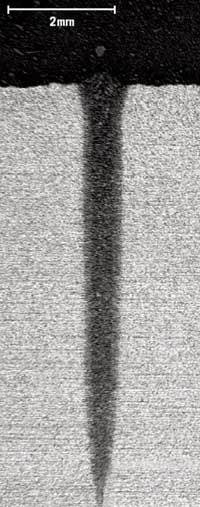Fiber laser welding
Researchers at Fraunhofer IWS put fiber lasers through extensive comparative tests
Eckhard Beyer
Recent developments in high brightness lasers are resulting in more application possibilities for laser materials processing in new and different fields. Take the well-established rod type solid-state laser as an example; two basically different developments are notable: on one hand, the diameter of the rod can be enlarged and the length of the rod reduced to a few hundred micrometers, which leads to the disk laser. On the other hand, lengthening the rod and reducing the diameter at the same time leads to fiber lasers.
With regard to the fiber laser, the length of the fiber guarantees a diffraction-limited laser beam. In such a laser system, the resonator does not need adjustment, because only a diffraction-limited beam will result. In addition to these two fiber laser advantages, a third makes it possible to guide the pumped energy, also via a passive fiber, into the active laser fiber, eliminating the need for alignment of the pumping diode lasers to the fiber laser.
Figure 1 shows the beam parameter product (BPP) as a function of the output power for different commercially available industrial laser systems, where a smaller BPP indicates a better beam quality. In comparison to the other lasers, the fiber laser represents a better beam quality, except when compared to CO2 lasers in the 5-10 kW power range. This is one reason why we, at Fraunhofer, are convinced that the fiber laser has a promising future.
At the Fraunhofer IWS in Dresden, Germany, and the IWS subsidiary in Plymouth, Michigan, we have the high-power fiber lasers shown in the table available for industrial process development studies.
The special features of these fiber lasers include the following: a very compact system, no mechanics between pumping diodes and focusing optic, no need for alignment, and high wall plug efficiency (25-30 percent). In addition fiber lasers have excellent beam quality and guaranteed high diode lifetime (50,000 hours). This leads to possible use of small and compact focusing heads and the smaller size and weight of used scanner optics, which enables higher scan frequencies.
The length of a 15-micron (diameter) fiber is limited to a few meters because of the Raman scattering effect, which would reduce the output beam power in case of longer length. A 50-micron fiber is limited to 15 meters length, the 100- and 200-micron fibers are considered unlimited in length.
If a beam switch or a fiber-fiber coupler is integrated, a 100-micron fiber has to be used instead of a 50-micron one, or a 200-micron instead of a 100-micron fiber. In these cases, a beam parameter product of 8 mm/mrad, that is, the same beam quality as of the disk laser, will be reached, and then the welding results of both the fiber and disk lasers are comparable.
In general, the system at Fraunhofer has been running without any problems like those we experience with our lamp-pumped rod systems. Optical feedback from the work being processed, a factor that is occasionally mentioned by other fiber laser users, has not been a problem so far. Furthermore, our measurements show that those optical feedbacks that emerge do not influence the output power. Nevertheless, we have always performed our studies with the beam not perpendicular but at an angle of six degrees to the workpiece. No problems have arisen during the cutting and welding of steel and aluminum, but the same processes using copper as the workpiece material are more sophisticated and should be treated with caution and sensitivity.
In our studies, because of the excellent beam quality of the fiber laser, welding depths and speeds have been reached that can only be compared to the narrow fusion zones developed in electron beam welding. Figure 2 exemplifies these results; 4kW fiber laser weld in 8mm-thick mild steel used in an automotive gear clutch assembly.
The fiber laser seems to be an excellent tool for low distortion welds, which are needed not only for powertrain components but also in applications such as remote welding.
Because of the very high beam quality, very small and compact focusing and scanning optics can be used without changing the welding parameters. Also the far field remote technique can be applied. In both cases, the laser beam with its high beam quality produces distinct welding plasmas, thus, in contrast to Nd:YAG and disk lasers, shielding gases should not be neglected. Absorption and mainly scattering effects can or will be observed.
Figure 3 shows the welding speed as a function of welding depth for fiber, disk, Nd:YAG, and CO2 laser systems. Because of the limited power of our CO2 laser we have carried out the comparative tests only with 3.5 kW. The welding results of the disk laser are slightly skewed, because we used data received for 4kW output power from TRUMPF’s HLD4002 disk laser. The same applies to the data we received from BIAS Bremen regarding its 4.0kW YLR7000 fiber laser (300 micron). Nevertheless, the figures demonstrate that it is not the laser type that is responsible for the welding results, but the beam parameter product, as the two different fiber laser curves in Figure 3 show.
In conclusion it can be stated that the high-power fiber laser is very suitable for welding and cutting applications. High beam quality offers better performance and more possibilities than other systems. Thus, the above-described advantages of the fiber laser should offset possible upcoming problems and phenomena.
On the other hand, a variety of other criteria will play an important role for the decision to purchase this laser or not. These criteria include the investment costs, running costs, and maintenance and service costs.
Nevertheless, the key point is that in the final analysis the process has to run repeatedly and reproducibly. Therefore the beam quality is an essential factor.
Finally it can be stated that with the development of the high-power fiber laser we have already taken the step into a new laser century.
Professor Dr.-Ing Eckhard Beyer ([email protected]) is the executive director of the Fraunhofer Institute for Material and Beam Technology (IWS) Dresden, Germany.




